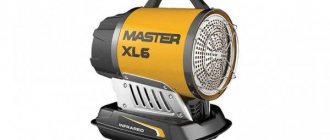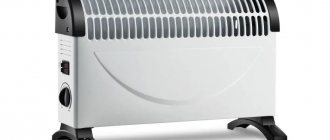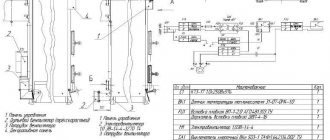Heating private houses with gas is a common occurrence these days, and this is not surprising: it is cheaper than heating with electricity. Many country and cottage settlements have gas mains, and if there is no main line, and its construction is not expected, then autonomous gas tanks are at your service.
A gas convector (catalytic gas heater) has the following operating principle: the air flow passing through the device is heated by gas combustion products (combustion products must be removed from the room). Convectors operate either on natural gas (from main gas pipelines) or on liquefied gas (propane-butane in cylinders or gas holders).
Convectors are used for heating any premises, both residential and utility. That is why when choosing a convector it is important to understand for what purpose it is being purchased. According to the type of installation, gas convectors can be wall-mounted or floor-mounted; below we will consider devices with both mounting options. There are not many manufacturers of this equipment, so some companies will be represented in the ranking more than once.
Editor's Choice
1.Hosseven HHS-9V 9 kW (average cost ≈ 33,000 rubles)
Hosseven HHS-9V 9 kW.
Photo: market.yandex The first in the top three is the floor convector HHS-9V from the Turkish company Hosseven. It has a high heating power of 9 kW, which allows it to effectively heat the air in spacious rooms. This is probably the most productive unit in this price category. It works both on liquefied gas from a cylinder or gas holder, and natural gas from the main line. For greater efficiency, the device is equipped with a fan and an automatic temperature maintenance function.
Main characteristics:
| Heating power | 9 kW |
| Combustion chamber type | closed |
| Heat exchanger material | steel |
| Additional functions | thermostat, fan, piezo ignition |
| Height | 640 mm |
| Width | 785 mm |
| Depth | 260 mm |
| Weight | 22.5 kg |
High heating power, presence of a fan
Noisy fan operation noted
show more
Karma BETA 5 Mechanic 4.7 kW (average cost ≈ 35,000 rubles)
Karma BETA 5 Mechanic 4.7 kW.
Photo: market.yandex Wall-mounted convector with very high declared performance from the Czech company Karma. The manufacturer talks about the possibility of heating a room of 100 square meters. m. with a power of 4.7 kW. However, no real tests could be found to support this claim. However, there is a very high efficiency of this model - about 92%. The combustion chamber is closed, ignition is piezocrystalline. It is possible to automatically maintain the temperature in the range from 13 °C to 38 °C. The heater operates on both natural gas and liquefied gas.
Main characteristics:
| Heating power | 4.7 kW |
| Combustion chamber type | closed |
| Heat exchanger material | steel |
| Control | mechanical |
| Gas type | natural gas, liquefied gas |
| Height | 600 mm |
| Width | 808 mm |
| Depth | 215 mm |
| Weight | 30 kg |
| Additional functions | piezo-crystal ignition, thermostat |
Declared high performance, the manufacturer emphasizes the use of high-class components in the device
No fan
show more
Hosseven HP-8 6.2 kW (average cost ≈ 41,000 rubles)
Hosseven HP-8 6.2 kW.
Photo: market.yandex The “designer” convector with wall mounting closes the top three. The power is very high - 6.2 kW, which is suitable for almost all residential premises, and the attractive appearance will help to fit the device into the design of the room. The combustion chamber is closed, the heater is also equipped with a thermostat and automatically maintains the room temperature in the range from 13 °C to 35 °C.
Main characteristics:
| Heating power | 6.2 kW |
| Combustion chamber type | closed |
| Heat exchanger material | steel |
| Height | 505 mm |
| Width | 900 mm |
| Depth | 200 mm |
| Weight | 28.5 kg |
| Additional functions | thermostat |
Appearance, high heating power
High price, no fan
show more
Power and gas consumption
The choice of power depends on the area of the heated room. On average, 1 kW corresponds to 10 m2. The approval is suitable for standard buildings with a ceiling height of up to 3 meters.
The market offers household appliances from 2 to 12 kW. You need to choose a convector with a power reserve for drafts, ventilation, and poor insulation.
There is another formula for calculating power. The area of the room is multiplied by a correction factor (expressing operating conditions). Its meaning corresponds to:
- 0.1 - for bottled gas;
- 0.12 - when the convector serves as the main source of heating and is actively used during the day;
- 0.15 - the value is typical for poorly insulated or non-residential buildings.
Gas consumption depends on its type and number of devices. One kilowatt of power corresponds to a consumption of 0.11 m3/h of natural gas and 0.09 m3/h of liquefied gas.
To reduce the consumption of the convector, it is necessary to install a thermostat or additionally insulate the room. Correct installation of windows reduces fuel consumption by 20%.
What other gas convectors are worth paying attention to?
Alpine Air NGS-50F 4.9 kW (average cost ≈ 31,000 rubles)
Alpine Air NGS-50F 4.9 kW.
Photo: market.yandex Wall-mounted convector of the Turkish manufacturer Alpine Air NGS-50 with a stated power of 4.9 kW. It is designed to operate on both liquefied and natural gas. The combustion chamber is internal, the heat exchanger is made of cast iron, which has a positive effect on maintaining temperature. The device is equipped with a continuously adjustable thermostat. The ignition is electric, but no connection to the mains is required - you need an AA battery. How convenient it is is up to you to decide. Electronic control. The model comes with a fan to enhance convection, but if you don't need one, consider the Alpine Air NGS-50.
Main characteristics:
| Heating power | 4.9 kW |
| Combustion chamber type | closed |
| Control | electronic |
| Gas type | natural gas, liquefied gas |
| Heat exchanger material | cast iron |
| Additional functions | thermostat, fan |
| Height | 630 mm |
| Width | 605 mm |
| Depth | 250 mm |
| Weight | 30 kg |
Cast iron heat exchanger, fan included
Electric ignition from a battery, not from the mains
show more
Alpine Air NGS-30F 3 kW (average cost ≈ 24,000 rubles)
Alpine Air NGS-30F 3 kW.
Photo: market.yandex Compact but quite powerful Alpine Air NGS-30F 3 kW convector with fan. The device can be connected both to the mains and to autonomous gas sources, and the fan will distribute heat more efficiently. Electric ignition is battery powered, which in some cases can be very inconvenient. Electronic control will be a definite plus for some users. There is also a fanless option: the Alpine Air NGS-30 model.
Main characteristics:
| Heating power | 3 kW |
| Combustion chamber type | closed |
| Control | electronic |
| Gas type | natural gas, liquefied gas |
| Heat exchanger material | cast iron |
| Additional functions | thermostat, fan |
| Height | 630 mm |
| Width | 455 mm |
| Depth | 250 mm |
| Weight | 23.5 kg |
Relatively small size, high power for small dimensions, presence of a fan, cast iron heat exchanger
Users note inconvenient controls, electric ignition from a battery
show more
Hosseven HDU-3V Fan 2.7 kW (average cost ≈ 25,000 rubles)
Hosseven HDU-3V Fan 2.7 kW.
Photo: market.yandex Convector for wall installation with an internal combustion chamber. Works on both natural and liquefied gas. Electronic control will be attractive for some users, and the stated range of automatically maintained temperatures is from 13 ° C to 35 ° C. The thermostat has seven adjustment levels. An undoubted advantage is that the device has a built-in fan for more active injection of cold air and distribution of heated air.
Main characteristics:
| Heating power | 2.7 kW |
| Combustion chamber type | closed |
| Control | electronic |
| Gas type | natural gas, liquefied gas |
| Heat exchanger material | steel |
| Height | 635 mm |
| Width | 470 mm |
| Depth | 270 mm |
| Weight | 13.4 kg |
| Main gas consumption | 0.28 m³/h |
| Additional functions | piezo ignition, fan, thermostat |
| Installation method | wall |
Possibility of operation on both liquefied and natural gas, relatively small size, presence of a fan
Users note the fan is noisy and the assembly is not very neat
show more
Karma GAMAT WR 20 2 kW (average cost ≈ 29,000 rubles)
Karma GAMAT WR 20 2 kW.
Photo: market.yandex Another compact wall convector Karma GAMAT WR 20 2 kW. A distinctive feature is the vertical design, which is suitable in cases where there is little space in the room. The device has the function of automatically maintaining the temperature from 13 °C to 35 °C.
Main characteristics:
| Heating power | 2 kW |
| Gas type | natural gas, liquefied gas |
| Combustion chamber type | closed |
| Control | mechanical |
| Heat exchanger material | steel |
| Height | 590 mm |
| Width | 316 mm |
| Depth | 150 mm |
| Weight | 16 kg |
| Additional functions | piezo ignition, autonomous temperature maintenance |
Small size, relatively light weight, good power with small dimensions
No fan
show more
FEG Konvektor GF30P 3.3 kW (average cost ≈ 37,000 rubles)
FEG Konvektor GF30P 3.3 kW.
Photo: market.yandex The device from the Hungarian manufacturer FEG Konvektor GF30P has a power of 3.3 kW and is designed for wall mounting. The combustion chamber is closed and made of cast iron. The device can automatically maintain the temperature in the range from 13 °C to 38 °C. The vertical design is suitable for small spaces.
Main characteristics:
| Heating power | 3.3 kW |
| Combustion chamber type | open |
| Heat exchanger material | cast iron |
| Height | 650 mm |
| Width | 500 mm |
| Depth | 325 mm |
| Weight | 34 kg |
| Additional functions | thermostat |
Cast iron heat exchanger, low operating noise
High price, no fan
show more
Gorenje MORA 6150.1022 2.5 kW (average cost ≈ 18,000 rubles)
Gorenje MORA 6150.1022 2.5 kW.
Photo: market.yandex An inexpensive and functional unit from the Czech company Gorenje. If you don’t need anything extra and don’t want to overpay, then this is your choice. The device is equipped with a thermostat (from 10 °C to 32 °C), can operate on both natural and liquefied gas, and most importantly, its dimensions allow it to be installed under a windowsill.
Main characteristics:
| Heating power | 2.5 kW |
| Combustion chamber type | closed |
| Heat exchanger material | steel |
| Installation method | wall |
| Height | 376 mm |
| Width | 552 mm |
| Depth | 206 mm |
| Heat exchanger | steel |
| Additional functions | start button, piezo ignition, thermostat |
| Weight | 12.8 kg |
Low price, dimensions allow the heater to be installed under a windowsill, light weight
No fan
ATON Vektor 2.2 kW (AOGC) (average cost ≈ 13,000 rubles)
ATON Vektor 2.2 kW (AOGC).
Photo: market.yandex Probably the most inexpensive option on today's market is a convector from the Ukrainian company ATON. The set of functions is standard; the device operates both from the mains and from the cylinder. Particularly pleasing is the presence of a thermostat with automatic maintenance of the set temperature. The low price is very attractive, but it should be remembered that this brand is not widespread in our country, so consumers do not have much experience in using it.
Main characteristics:
| Heating power | 2.2 kW |
| Combustion chamber type | closed |
| Heat exchanger material | steel |
| Gas type | natural gas, liquefied gas |
| Installation method | wall |
| Height | 590 mm |
| Width | 459 mm |
| Depth | 249 mm |
| Weight | 18.5 kg |
| Additional functions | thermostat |
Low price, light weight
No fan, unknown brand
FEG Konvektor GF 35 P
Equipped with a heat exchanger, which is made from special high-strength steel, which is pre-heat treated. This element is manufactured using a unique patented technology, which ensures instant heat transfer to the environment. The device will not overheat or shut down even under the most severe operating conditions.
It runs on natural gas and is almost silent - no clicks or crackles were detected. If necessary, the device can be converted to propane or butane in cylinders. The design is characterized by increased power, but the external design is a bit disappointing - many consumers find the convector unsightly.
Advantages:
- Capable of running on propane and butane from cylinders;
- Operates absolutely silently;
- Adapted to harsh Russian working conditions.
Flaws:
- Not very stylish case design.
How to choose a gas convector
Despite the fact that there are not very many manufacturers of gas convectors, and the range itself is not very large, making a choice can be difficult. Komsomolskaya Pravda asked an expert to help understand the intricacies of choosing a gas convector.
Advantages and disadvantages
First, let's look at the main advantages and disadvantages of gas convectors as a class of heating devices. As advantages, we can definitely name high autonomy in operation, relatively compact dimensions (unlike gas boilers), and low installation complexity. However, a convector can only heat one room, and you will need to buy a separate unit for each room. In addition, gas combustion products must be removed. This means that you will definitely need to make an output from each device either to the street or to the chimney. Let's assume that you've weighed the pros and cons and decided that this is the heating method your home needs. In this case, you need to keep a number of parameters in mind.
Mounting method
There are three options for convectors depending on the mounting method: floor-mounted, wall-mounted and mobile. There are many devices that can be installed and hung; mobile gas convectors are now very rare, since their use is difficult due to the need for constant removal of gas combustion products.
Type of fuel consumed
Gas convectors operate either from main (natural) gas or from a liquefied mixture of propane and butane. Liquefied gas is pumped into autonomous gas tanks and cylinders. Now most devices are adapted to work with these two types of gas, and the corresponding adapters are included with the devices. When installing a gas tank, you need to very carefully calculate the expected volume of gas consumption, and this should be done by a specialist. Cylinders are of little use for space heating due to their volume.
Combustion chamber type
Convectors are equipped with either open combustion chambers (chimney convectors) or closed combustion chambers (parapet convectors). As the name of the first type suggests, these devices require a chimney to operate. Oxygen is taken from the surrounding air. Such devices are more powerful, but their efficiency is slightly lower than that of parapet ones. Moreover, their installation is a very difficult undertaking. Convectors with closed combustion chambers have higher efficiency and are easier to install. Using a special pipe (coaxial), combustion products are discharged outside and oxygen is taken. We must, however, remember that every hole in the wall is a violation of thermal and sound insulation, no matter how well you seal it. The second type is almost ubiquitous in everyday life.
Heat exchanger material
The heat exchanger is a very important part in the convector. Steel, cast iron or copper are used to make it. Cast iron is more durable, heats up slowly, but most importantly, cools down slowly, therefore, it retains heat better, and usually the efficiency of devices with cast iron heat exchangers is higher. Copper has very good thermal conductivity and retains heat well, but is more expensive than steel or cast iron, so it is rare.
This is interesting
The best electric convectors
Power, temperature and heating area
Manufacturers almost always indicate heating power in kilowatts. Some even indicate the heating area. However, this information should not be taken at face value. If the manufacturer does not indicate the heating area, then it can be roughly calculated using the following example: one kilowatt per 10 square meters of room. Therefore, a 2.5 kW device can be designed for 25 sq. m., power 6 kW – for 60 sq. m. etc.
In reality, everything is much more complicated. Effective heating of a particular area, of course, depends on the power of the heater. But the properties of a particular room have no less, if not more, influence. In particular, its volume (manufacturers talk about area, not volume!), the quality of walls, joints and doors; the presence or absence of furniture and other items in the room. The temperature “overboard” plays a huge role. Obviously, at 0 °C the result will be one, and at -25 °C completely different.
A similar approach is valid for temperature conditions declared by the manufacturer. It is better that any device in your home always has a reserve of power and performance.
Convection heating
Convection heating involves the use of the simplest laws of physics. Almost every person knows perfectly well that hot air tends to rise upward, displacing cold air masses downward. This is precisely the principle that was incorporated into gas convectors operating on bottled gas. It heats the air, it rises, displacing colder layers of air downwards, which is why they get to the heat exchanger.
Convection heating warms rooms using heated air generated by heating devices. At the same time, convection ensures smooth mixing of air masses - this cannot be seen with the naked eye, but the entire atmosphere in heated rooms is constantly in motion . Advantages of convection heating:
All convectors work on the same principle - warm air tends to rise, and cold air comes in its place.
- No effect on air composition - oxygen level remains the same;
- Minimal impact on the humidity of the home atmosphere - the drop in humidity can be compensated for by some kind of humidifier;
- Easy installation of equipment - no need to run pipes around the house and install a boiler.
True, some people don’t really like the feeling of overheated air, but this is how many heating devices work - you have to put up with it.
About the problems of traditional loggia heating options
Oh, and this is not an easy job - installing heated floors!
Heating a glazed and insulated balcony really involves a lot of difficulties. If you move a central heating radiator onto the loggia or install a warm water floor, then as much heat is added to your balcony, so much will be lost from your neighbors. They will certainly notice this and triple the scandal. Otherwise, even worse, they will inform the supervisory authorities, and you will be in trouble.
If you heat your balcony with electricity, then:
- firstly, it’s expensive;
- secondly, it is unsafe. A balcony is not an apartment; No matter how you glaze or finish it, flooding in the event of heavy rain is difficult to avoid. And where there is dampness, there is a short circuit with all the ensuing consequences.
The article “Options for heating a balcony or loggia: which is better?” He will tell you in more detail about traditional methods of heating glazed balconies and loggias
Is it possible to bypass the administrative ban on moving heating onto the balcony? Legal advice is here: https://oknanagoda.com/balkony-lodzhii/yuridicheskie-voprosy/zapret-vynosit-otoplenie-na-balkon.html
A separate thematic article on our website is devoted to heating balconies using warm baseboards
And it’s simply amazing how Moscow balcony owners and loggia owners have forgotten about such a simple and convenient thing as a gas convector.
Equipment installation
Installing the convector itself is not difficult; special requirements are placed on gas equipment, the installation and commissioning of which must be carried out by gas specialists. The heating process from bottled gas will also require the presence of a gas bottle installation, which should provide at least a 10-day supply of fuel. For large objects, gas tanks are installed.
Main stages of work, their features and requirements of SNiP standards:
- System design. During this stage, the thermal power of the installation, equipment and many other parameters are determined.
- Supply of equipment. Today there are no problems with the delivery of selected equipment; it can be organized via the Internet, directly to the buyer’s home.
- Installation and commissioning works with the execution of contracts with a specialized organization that will be responsible for the quality of work and safe operation of the installed equipment.
- Refilling the system with liquefied gas.
- Equipment service.
Basic requirements for installing a liquefied gas heating system:
- It is not recommended to store cylinders with liquefied gas outdoors; in the cold season, the heater may stop due to a decrease in gas pressure; it is recommended to place them in rooms adjacent to residential buildings.
- It is forbidden to place cylinders in basements or in rooms with a pit, since propane is heavier than air and, if it leaks, it can collect below, leading to an explosion.
- The gas tank must be equipped with a system of mechanical safety valves to relieve excess gas pressure into the atmosphere.
- The gas system must have a special reducer that regulates the pressure in the gas pipeline to the gas burner.
- During operation of convectors, it is necessary to follow the manufacturer's instructions, and in the event of a gas leak, close the valve.
Installation
According to GOST, installation should be carried out under the window space.
- Forming a through hole for supplying a gas pipe and a hole for the chimney.
- Preparing holes for mounting the system and installing brackets.
- Fastening the convector to the wall.
- Connecting the convector to the chimney and treating the joint with silicone.
- Connecting the system to the fuel source and treating the through holes with foam to prevent the passage of outside air.
- Checking the correct installation by responsible specialists and starting the heater for the first time.
Of course, the best option would be to carry out installation by a special team with the appropriate permits to prevent possible errors and waste of time.
The best mobile gas heaters for home and garden
Bartolini Pullover K
The Bartolini Pullover K gas heater can be used for efficient heating of various types of premises: houses and apartments, cottages, outbuildings and garages. It can become the main or additional (or backup) heat source. The device is mobile - it moves easily on wheels. The heating element of the device is a catalytic panel. It is made of fiberglass, and platinum powder acts as a catalyst. Thanks to the use of this technology, there are no harmful emissions and no odor in the room during operation of the heater. The fuel for the device is liquefied propane-butane. The design of the housing is such that the gas cylinder (27 or 24.5 l) is placed inside and covered with a casing. The heater is equipped with safety elements:
- Burner flame level control sensor;
- Rollover protection (automatic shutdown when tilted);
- Air condition monitoring sensor (shutdown when carbon dioxide concentration is exceeded).
Additional features:
- Piezo ignition;
- Power regulator.
Main advantages:
- Reliability;
- Quiet operation;
- Manufacturer: Italy.
Minuses:
- Large dimensions.
Models in the line:
- Bartolini Pullover K Turbo Plus
- has 3 positions (turbo mode, hot air, cold air), heated area 45 - 50 sq. m.
Timberk TGN 4200 SM1
Timberk TGN 4200 SM1 ceramic gas heater is an inexpensive, mobile and universal device. Its mobility is ensured by its compact body and wheelbase for easy movement. The capabilities of the device allow it to be successfully used for heating premises of various types and purposes. The heater operates from a propane-butane cylinder (up to 12 liters, regular or 12.5 liters composite), which is easily placed inside a metal casing. For connection, the kit includes a reducer, gas hose and clamps. The room is heated by infrared radiation generated when ceramic plates are heated by a gas burner. Such material ensures complete combustion of fuel, and, therefore, the air does not contain combustion products. For safe operation, the model is equipped with gas control and a CO2 concentration monitoring sensor. Additionally, rollover protection is provided. Piezo ignition and power regulator are used as control elements.
Main advantages:
- Affordable price;
- Mobility;
- Versatility.
Minuses:
- Periodic ventilation of the room is necessary.











